Ever wonder how your coffee is made in the morning? Well, if you’re one of those 121 million people who own a Keurig, we tore down the B130 single-cup brewing system to find out!
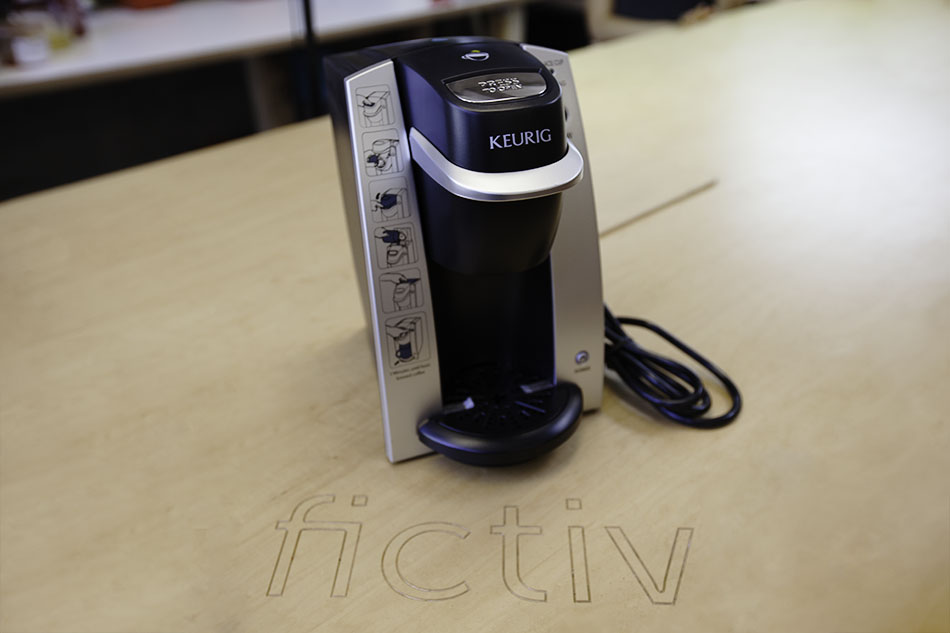
This Keurig is 11”H x 7”W x 10”D and weighs 6.5 lbs.
First, we took out the tray that contains the drip plate and tray, which are tapped together to remain intact during shipping. Both pieces are made of injection molded ABS.
The drip tray is a gloss finish, which is a highly polished, shiny surface. It is smooth, flat, and gives maximum reflection. The injection molding tool is polished by hand with diamond paste to achieve this kind of finish. In contrast, the drip plate has a matte finish, which is also achieved in-mold by etching the injection molding tool with laser, chemicals, or media blasting.
Textured finishes in plastic are more resistant to surface scuffs and scratches than flat surfaces are. Therefore, it makes sense that a textured finish is used where the mug will be placed, which is more prone to scuffs and scratches.
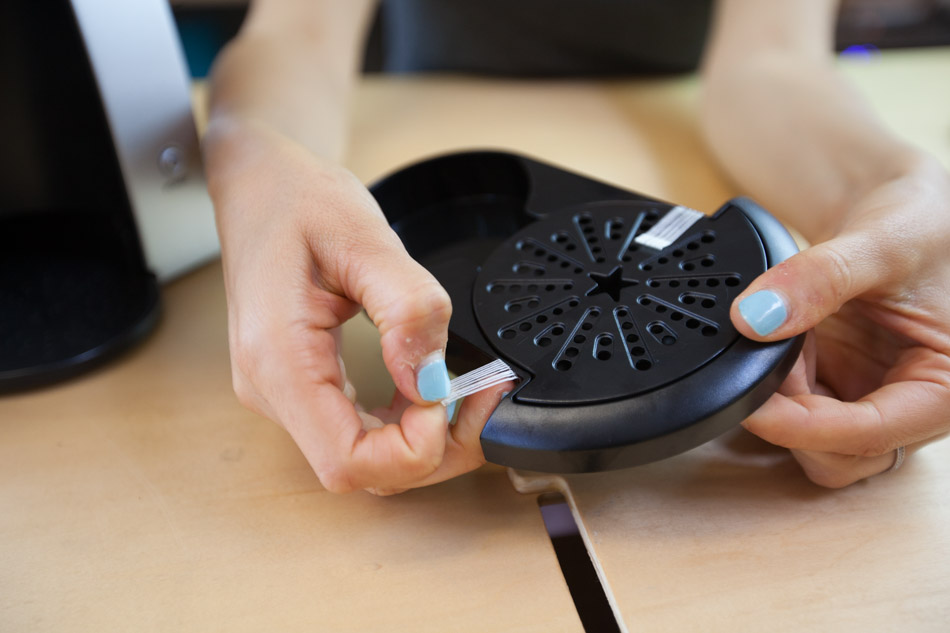
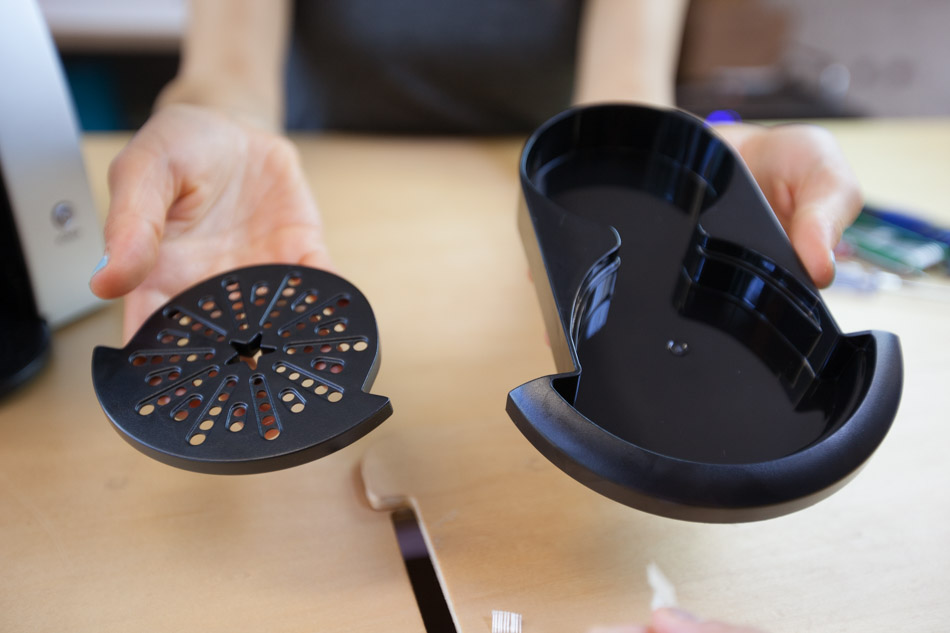
Now the fun begins! We started unscrewing the screws on the bottom of the Keurig. Most of the screws had Phillips heads, but there was one Torx security screw. We assumed this one had something special attached to it.
Once we unscrewed all twelve screws, we got to see the inside of the Keurig. Each screw had a nut and washer combination, because washers distribute the pressure of the nut evenly over the surface and ensure that the nut is pressed smoothly against the surface. There was also a cable strain relief made of injection molded polypropylene, to enlarge the bending radius of the wire harness to prevent wear and tear.

The Torx screw was indeed something special—it secured the grounding cables to ensure people did not mess around with this. Safety first!

We found a small PCBA (printed circuit board assembly) screwed to the bottom plate. The most prominent component on this PCBA is a thermocouple. The purpose of this PCBA is not clear; however, since it was placed on the bottom of the Keurig, far from the water heater, it’s possible it’s measuring the temperature of the base plate or even ambient temperature.
After we removed the PCBA, we noticed thermal paste between it and the bottom cover plate. This improves the thermal conduction between the thermocouple and therefore helps to get a more accurate reading of base plate temperature.
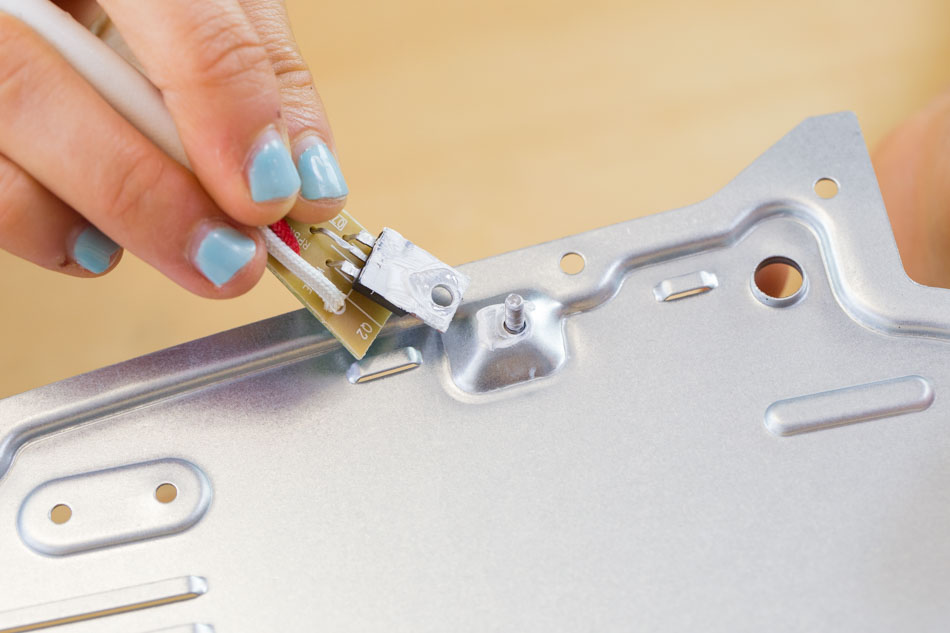
The bottom cover plate is stamped steel. During prototyping, this might have been CNC Machined. However, since stamping is faster and cheaper than CNC Machining, it’s more cost-effective to stamp the metal in mass production.
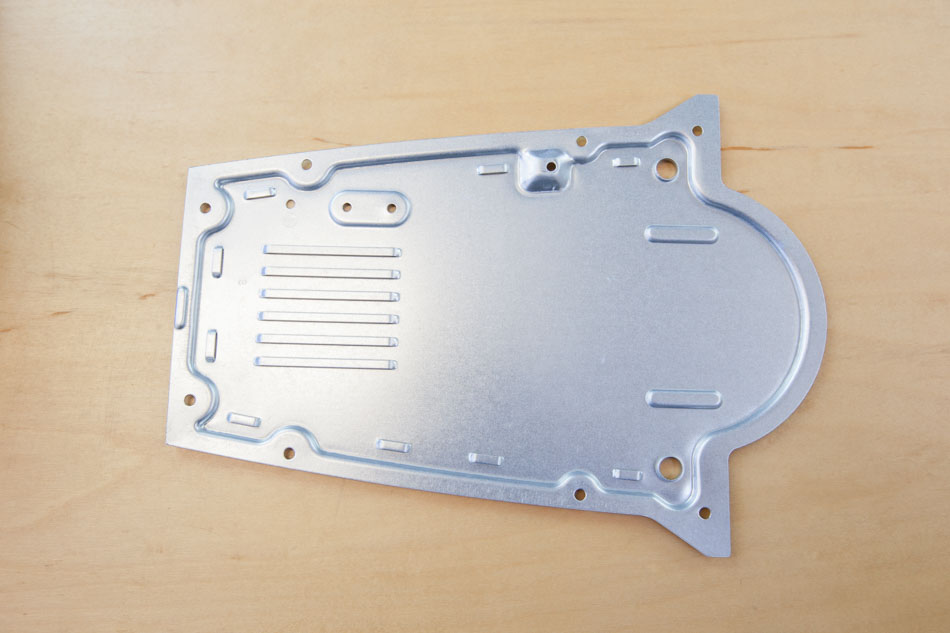
The bottom was a mess of wires, with an internal plastic bracket made from polypropylene (PP) to try to organize some of the wires and keep them in place. The bracket was made from polypropylene, which is cheaper than AB
S, to reduce cost.
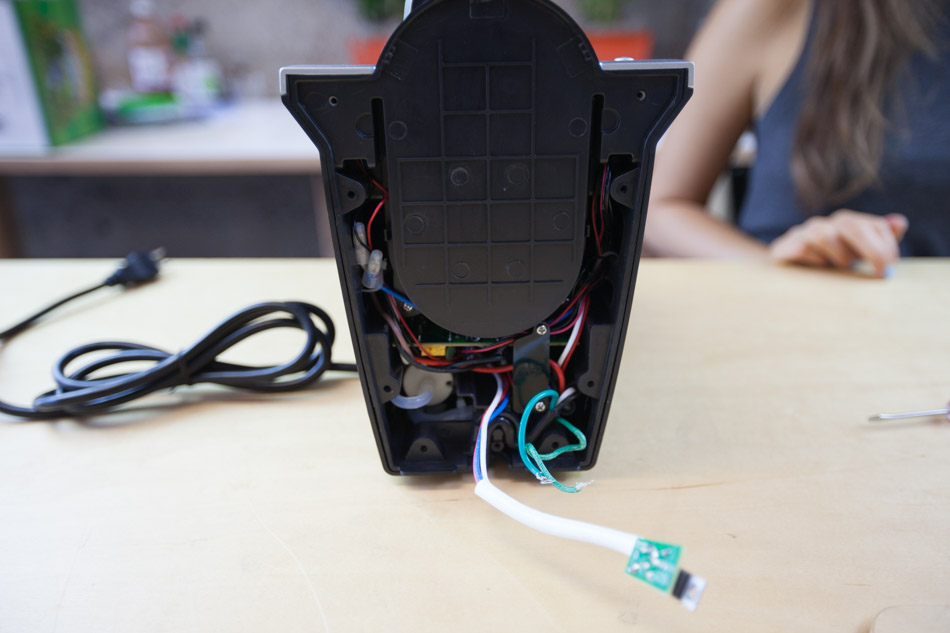
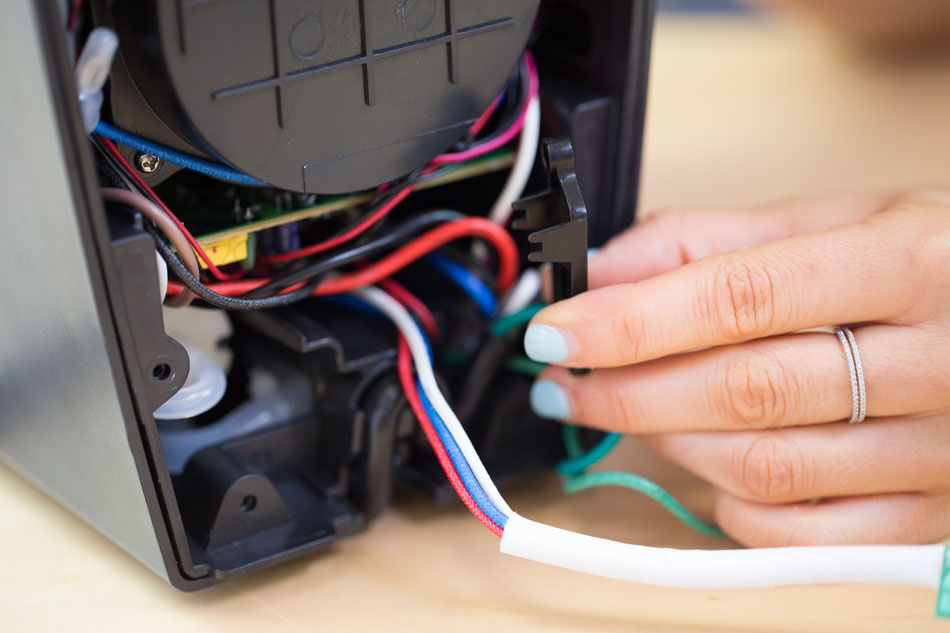
We removed the bracket and started pulling out the wires. They were connected via zip ties and crimp cover caps, to prevent shorting out.
After trying to pull at the wires for a few minutes, we realized it was a dead end to keep trying from the bottom and that we needed to try a different avenue. Therefore, we moved on, to the front of the Keurig.
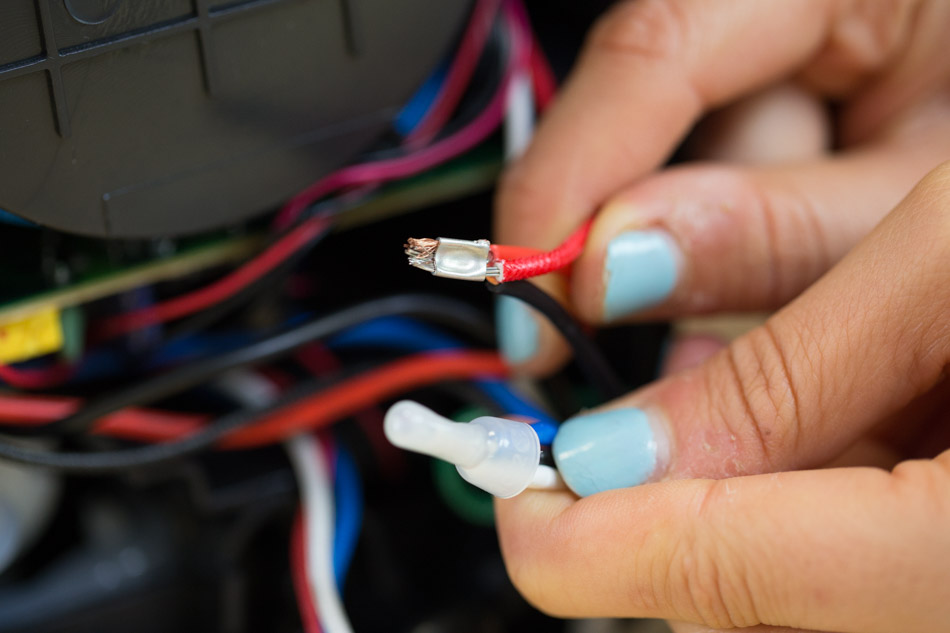
The front panels simply popped off. They were metallic painted ABS, with pad printed graphics.
They were held onto the Keurig by cantilever clips, snap fitted onto the frame. These clips had a 90° hook face in the direction of the connection. This means that the connection will lock and cannot be undone by a simple pull, unless you pull hard enough to break the clip.

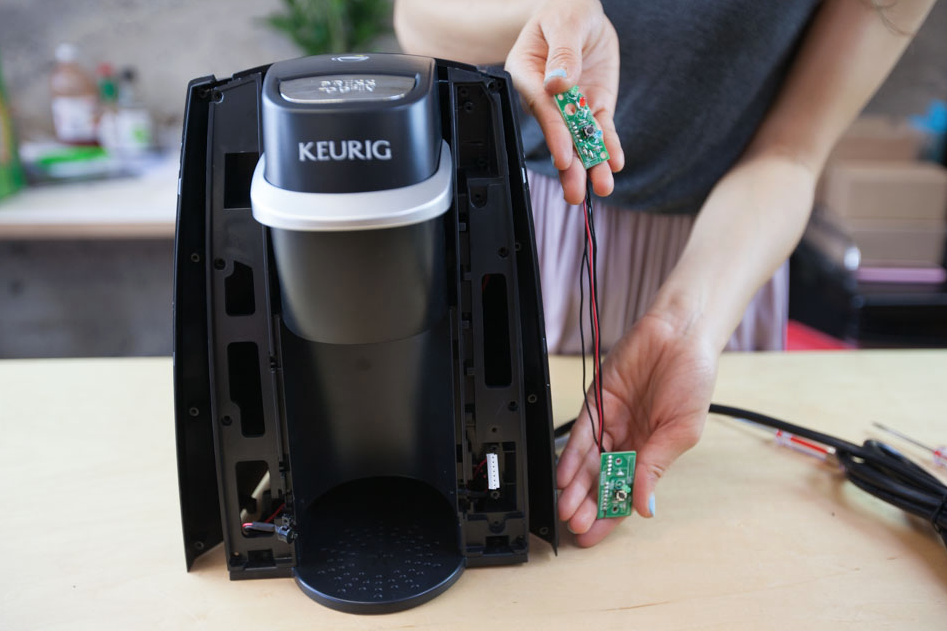
On the right side of the Keurig there were two PCBAs, at the top and bottom, hidden by the side cover panel. There was a polycarbonate light guide and a rubber gasket between the upper PCBA and cover panel. This rubber masked light, waterproofed the PCBA and softened the button feel.
The upper PCBA itself has three through hole LEDs and a push button switch.
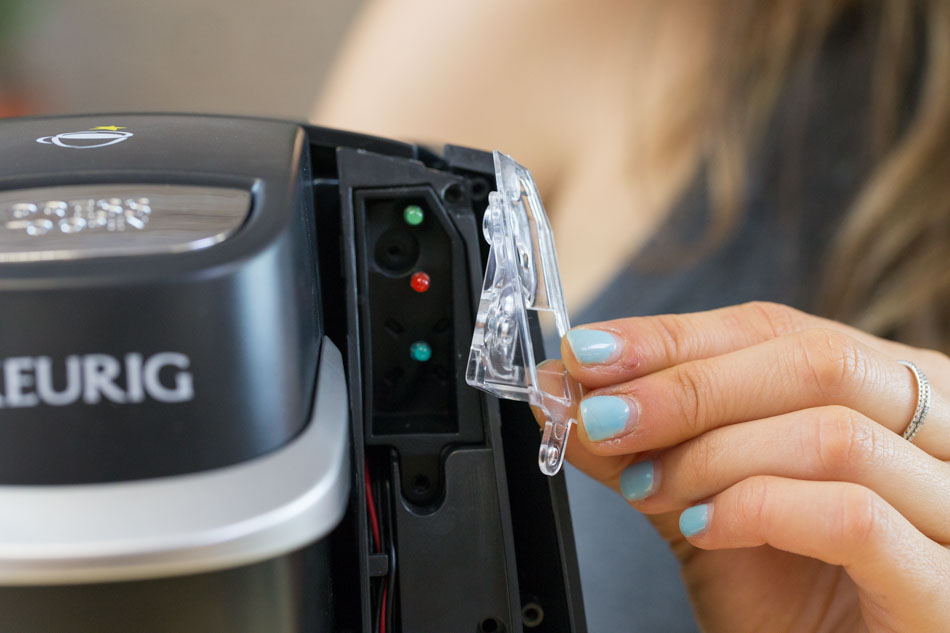
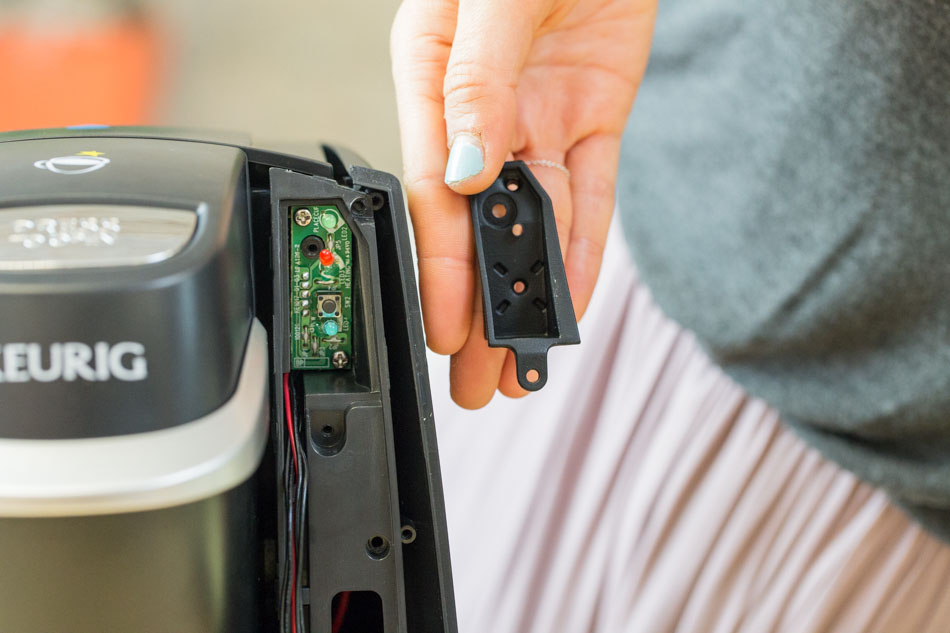
The upper green LED lit up the “PLACE CUP” light, the middle red LED lit up the “HEATING” light, and the lowest cyan LED lit up the “BREW” button.
The brew button top is made of polycarbonate, to let light through. It has a painted center and a pad-printed graphic. There’s a compression spring underneath for springback.

The lower PCBA had one LED and a push button switch. The green LED lit up the “POWER” button. It’s the same kind of mechanical stack: polycarbonate compression spring button top with compression spring, rubber gasket, and PCBA.
It also has a painted center and a pad-printed graphic.
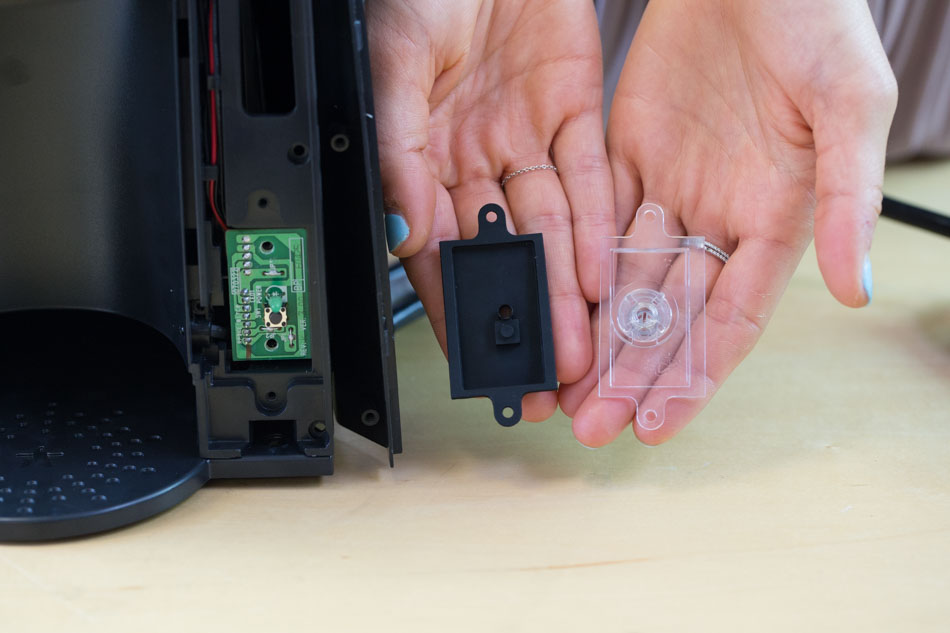
This button is much stronger and more durable than the “BREW” button above it. It has four cantilever clips and a compression spring inside and therefore cannot be taken apart without breaking the clips.
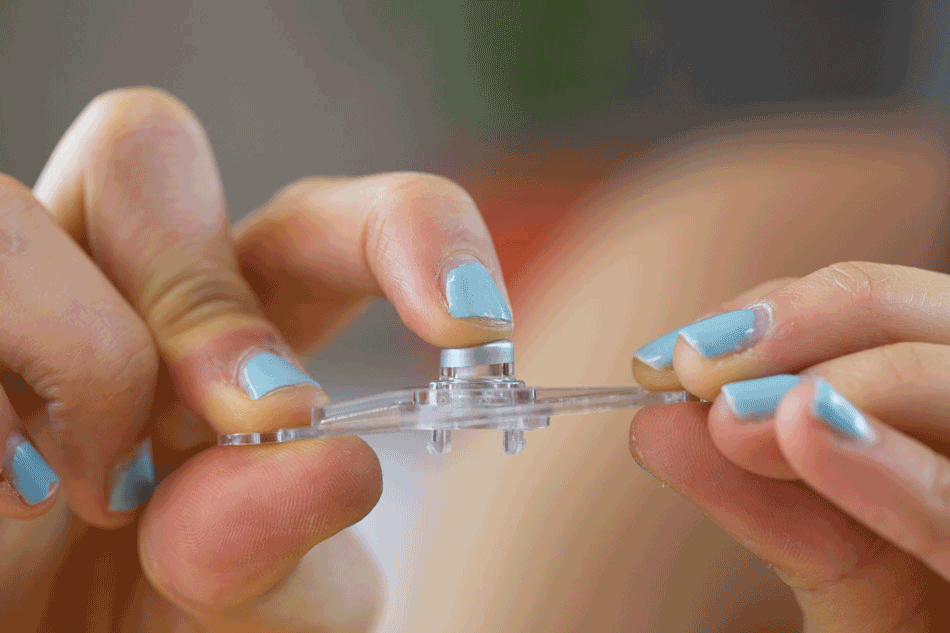
Like the bottom, the front became a dead end, so we decided to move to the top. The top had five separate apparatuses that were dissected separately.
- K-Cup holder
- Water tank
- Internal hydraulics
- Electronics
- Mechanical structure
K-Cup Holder
The handle, which is used to open and close the lid and puncture the K-Cup portion pack, is made from metallic painted ABS and was secured with two screws on both back ends and a clip on the top.
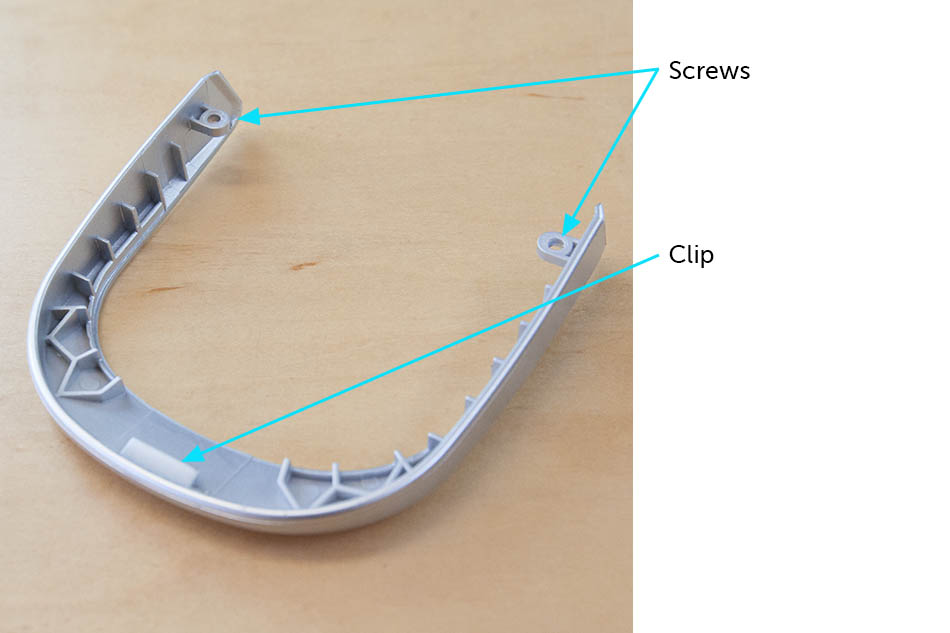
When you push the large “PRESS TO OPEN” button on the top of the brewer, which, although silver to appear like metal, is actually made from ABS, the K-Cup Holder is revealed. You can see how the K-cup is punctured from the top and bottom via sharp metal needles.
The K-Cup Holder Assembly is easily removable because it needs to be cleaned by the user. It’s interesting to note that it is made from polypropylene, rather than ABS.
This component is dishwasher safe and probably needs to be replaced often. We think that’s why it’s made from the cheaper polypropylene, rather than ABS—to help decrease cost to the user.
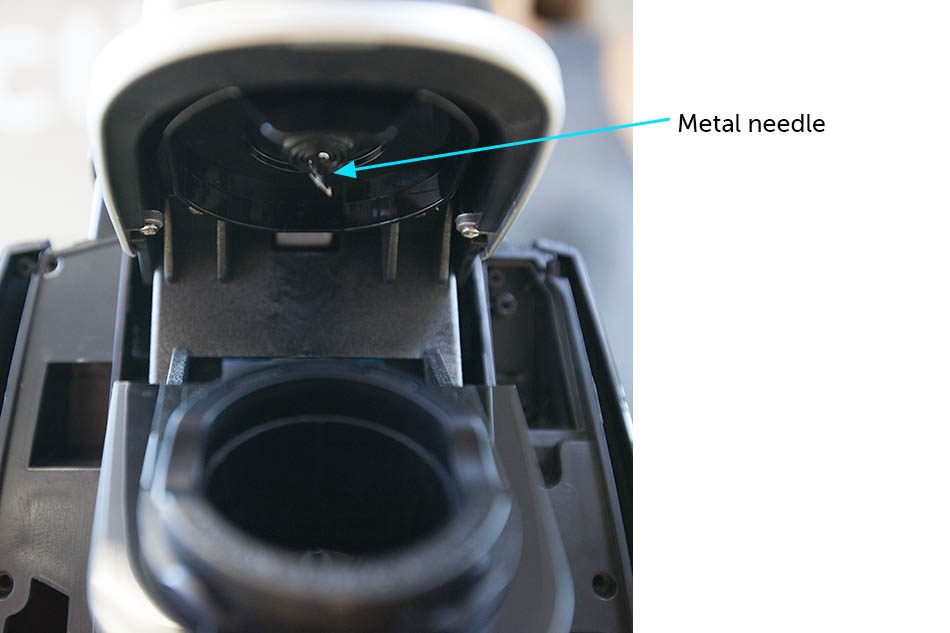

There’s a large “Caution” note in the manual regarding these needles that reminds users to be careful with these sharp objects.
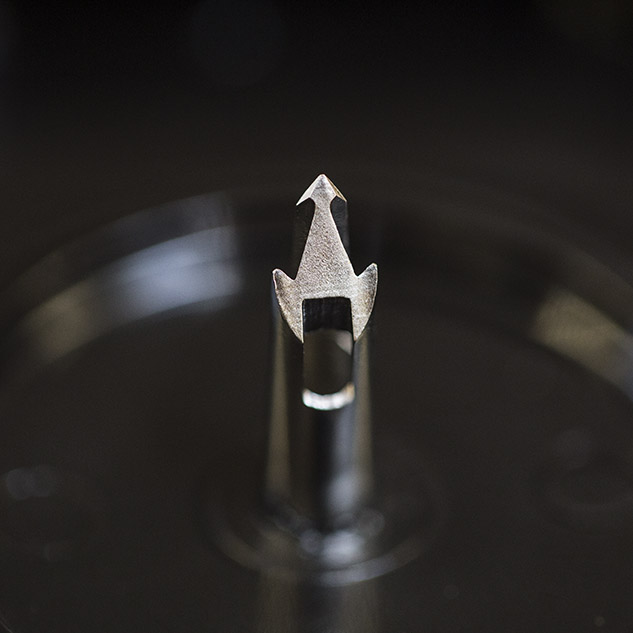
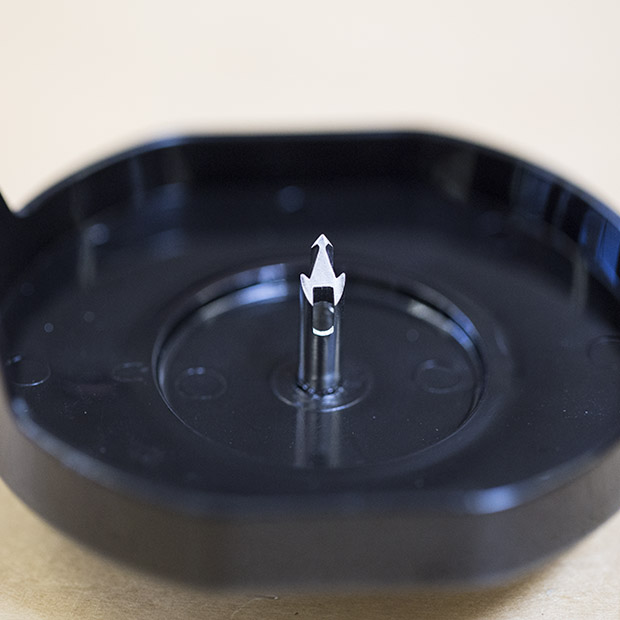
It even says “CAUTION – SHARP NEEDLES” on the rim of the K-Cup Portion Pack Holder. Keurig is really watching out for us 🙂
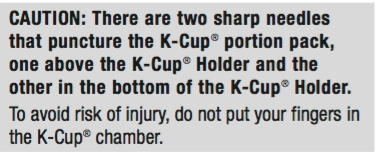
Water Tank
Once you’ve closed the lid on the K-Cup portion pack of the K-Cup Holder, the Hot Water Tank cover automatically opens to allow the user to fill the tank with water. The water tank lid popped off and had a flexible, caulking-like adhesive stucco below, along with a PCBA. The PCBA is used to sense whether the lid is open or closed.
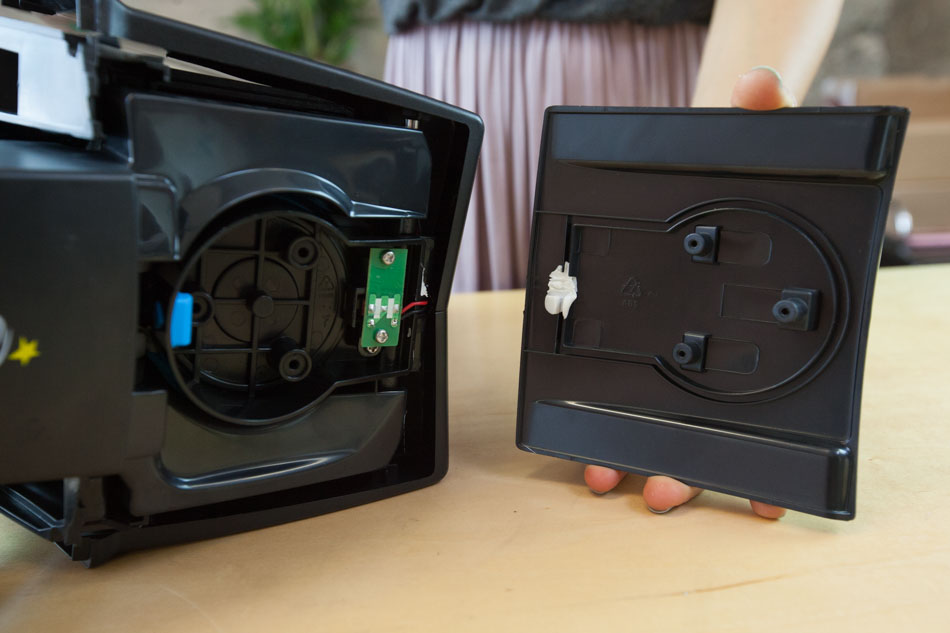
Under the hot water tank cover is a fancy decorative steel-stamped “Water Only” plate, encompassed by a rubber ring. This rubber ring acts as a protective layer, so that the water in the tank does not come out of this section when being heated. There’s also another rubber ring below the water only plate, to further ensure waterproofing.
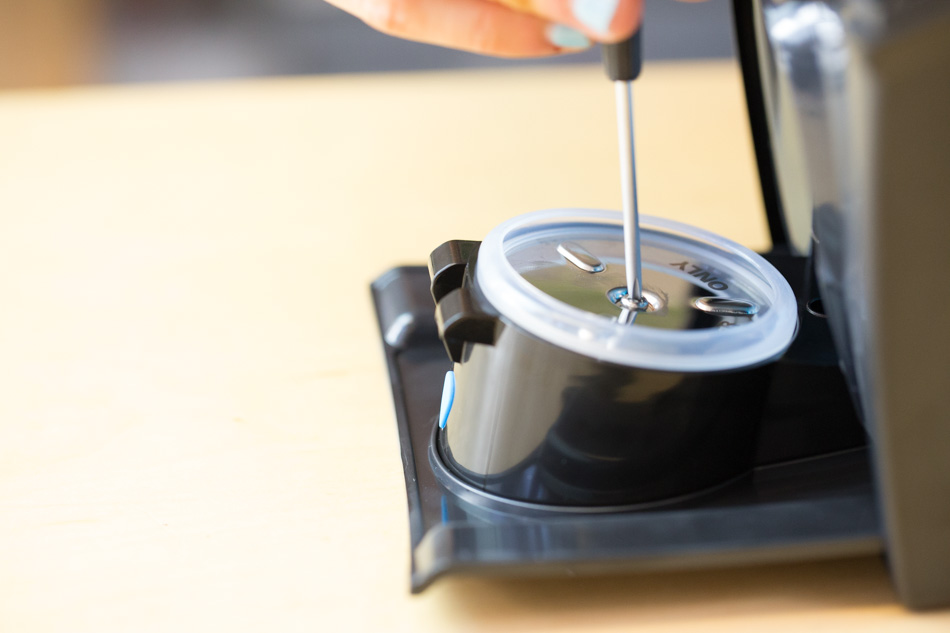
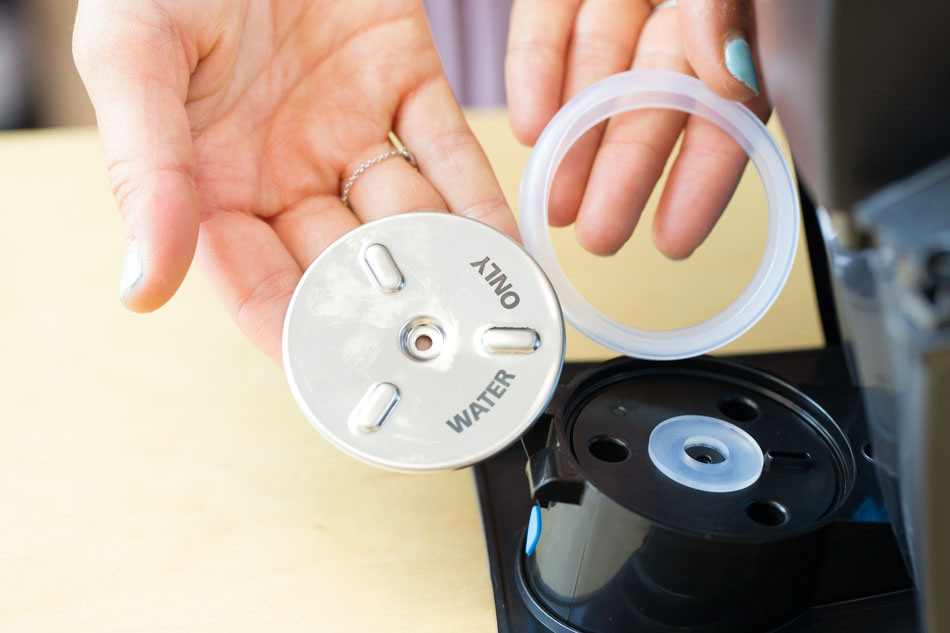
This exposed a tiny screw that was preventing the housing from coming off. After unscrewing this screw, the possibilities became endless! (or just the housing came off…)
Nevertheless, I was really excited about that…
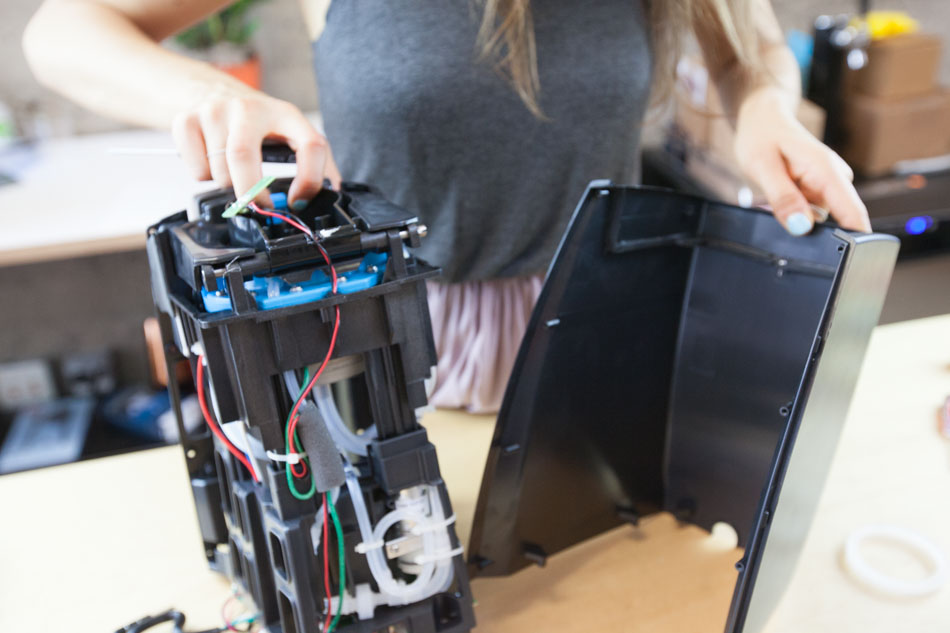
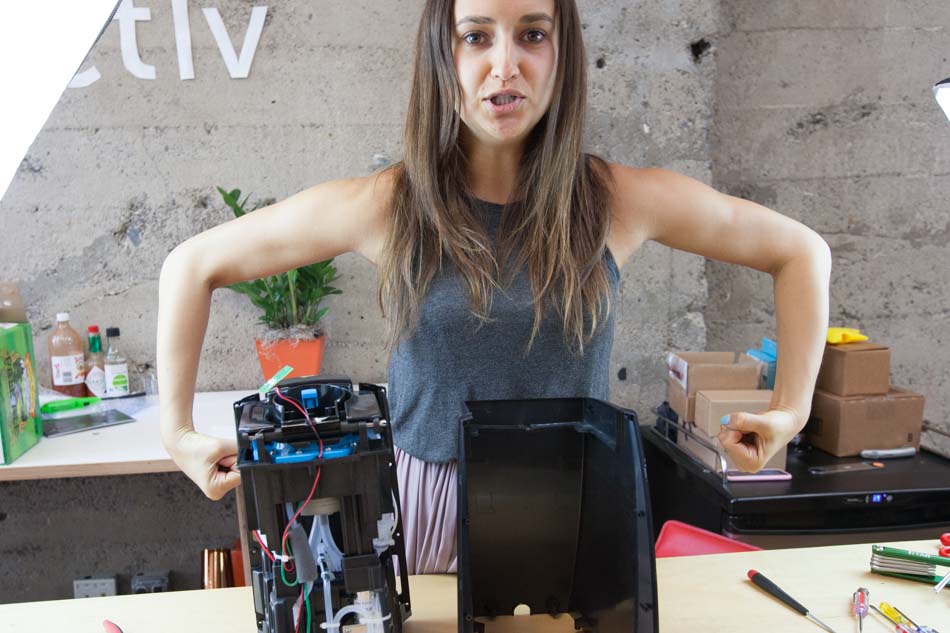
The back housing was a large, U-shaped piece of ABS, with a matte finishing on the outside and no finish on the inside. This is to conserve time, energy and money, since the user will not be seeing the inside of the machine.
The core of the Keurig had lots of zip ties in a weak attempt to organize all of the the wires and water tubes. This is an easy way to keep manufacturing and assembly costs down when space is not an issue, but it’s fairly janky and disorganized.
After cutting all of the zip ties, pulling the tubes from the suctions, and unscrewing some more, we were able to pull the Keurig apart further, into internal hydraulics, electronics, and mechanical structure.
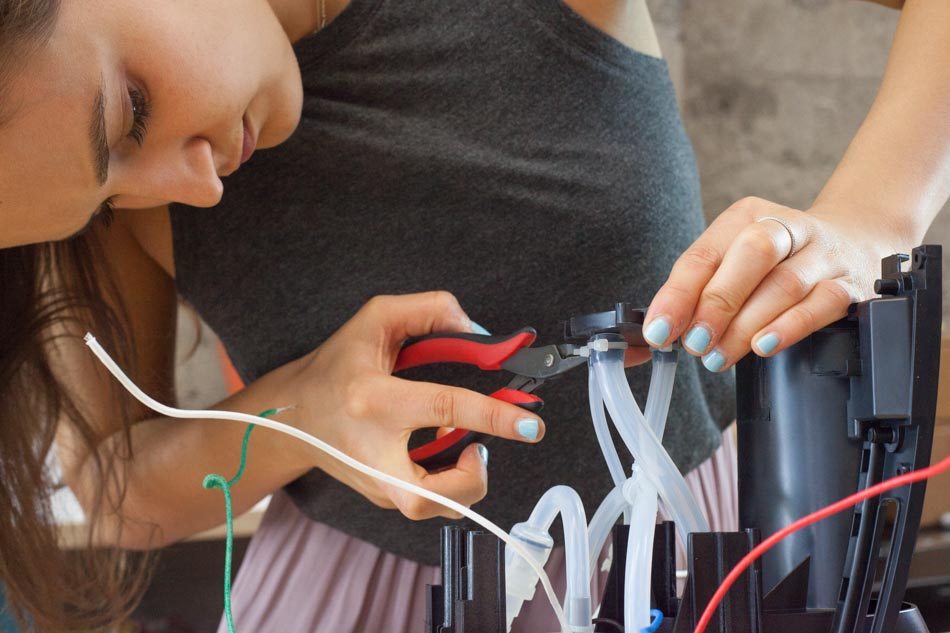
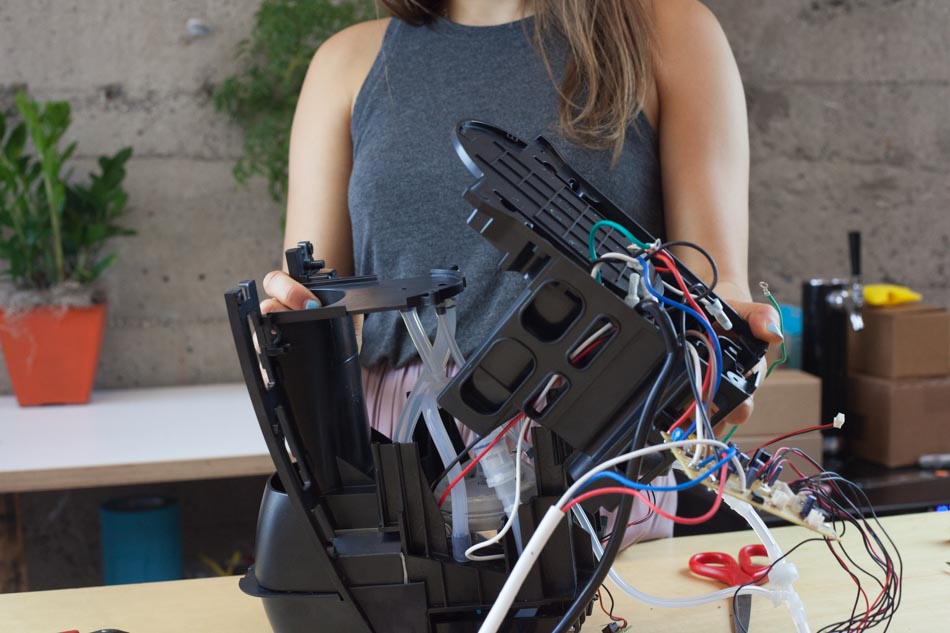
Internal Hydraulics
This held the steel stamped “Water Only” plate and is made from polyoxymethylene (POM). POM is also known as acetal, polyacetal, and Delrin and is used in strong and precise plastic parts. It has a blue rubber water droplet wedged behind the plastic for decoration.
It is minimally secured by the plastic clamps, to save material and therefore cost, since POM is expensive.
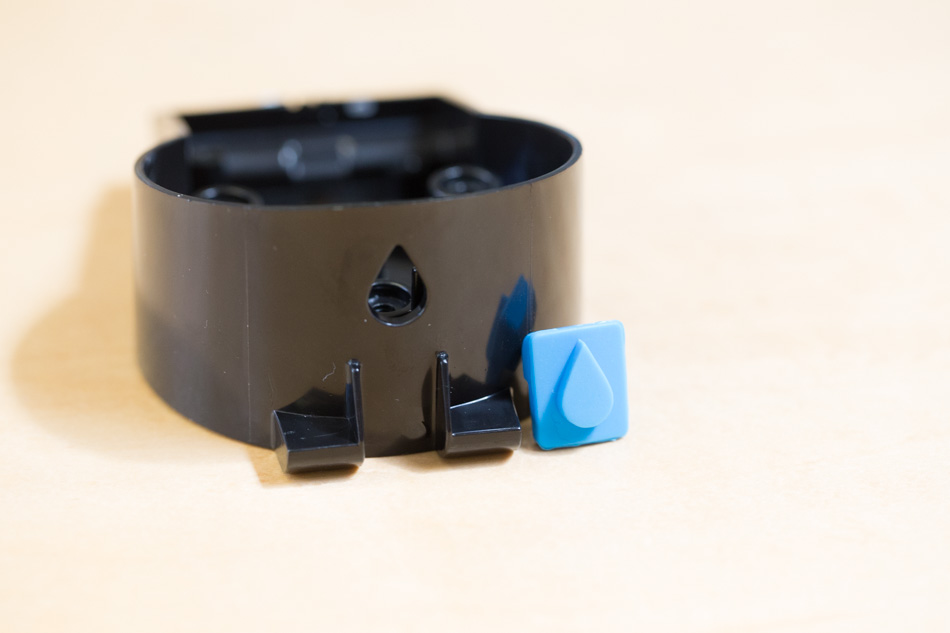
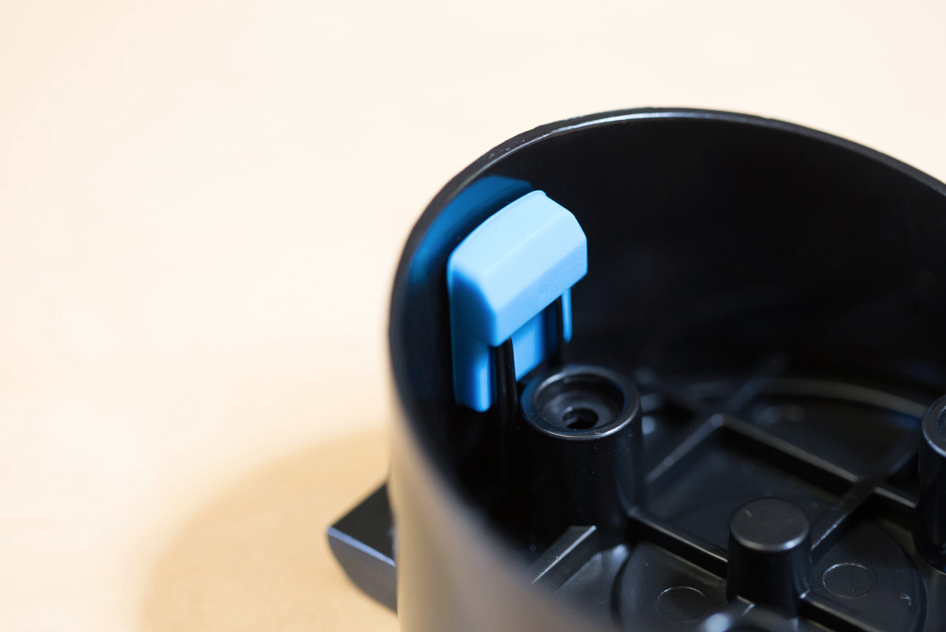
The rest of the hydraulic system is hidden away by the elegant outer housing. The average user would never imagine this tangled mess inside.

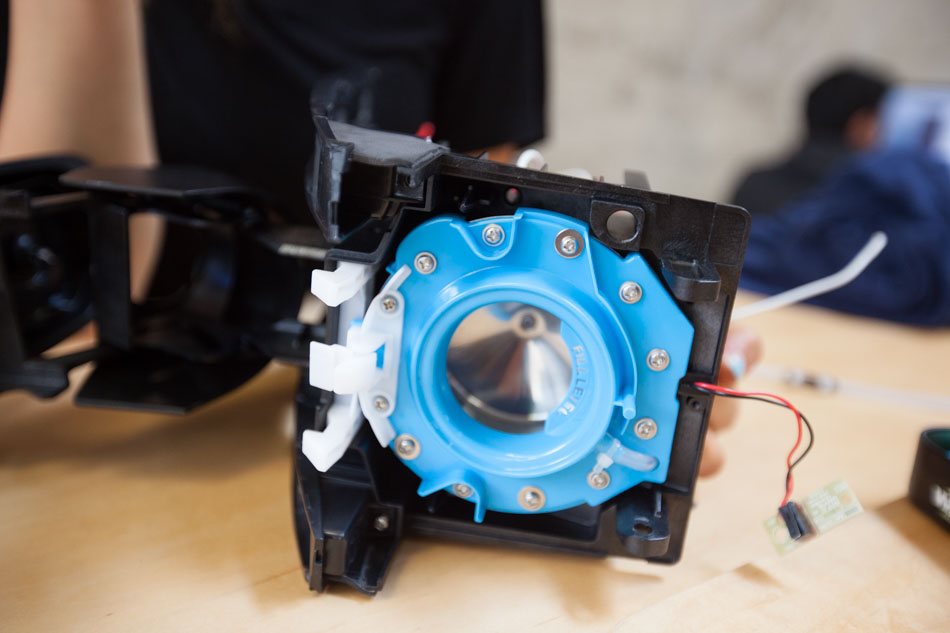
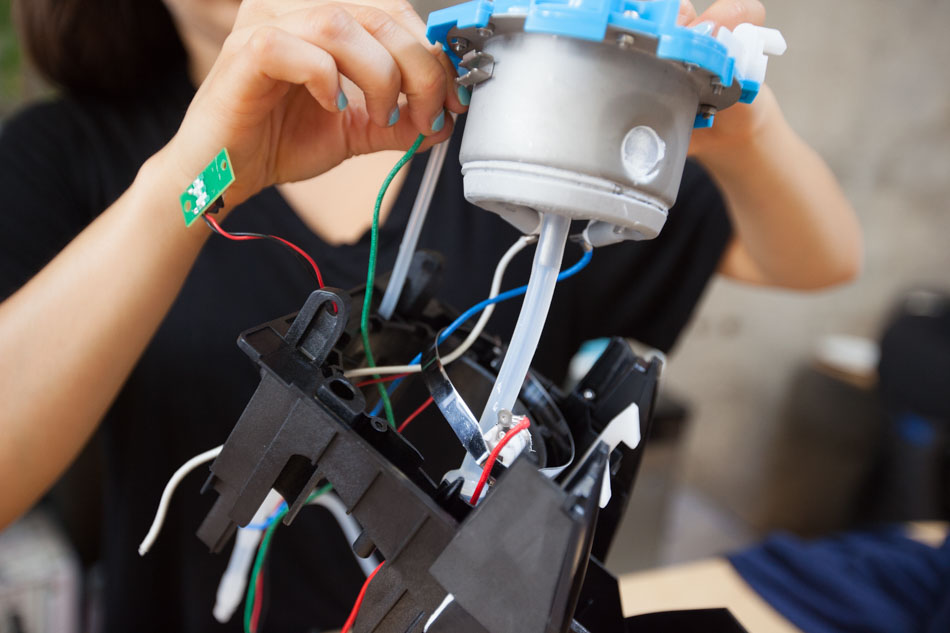
After unscrewing, we disconnected the aluminum water heater and blue POM cover. The Keurig boiler works by some kind of electric filament, with enough resistance to heat up when current passes through. This is wrapped around the base of the metal and heats the water until it reaches 192 degrees.
The inside cnc aluminum is polished nicely, while the outside is left unfinished. The blue cover is made of POM because of its high stiffness, low friction, and excellent dimensional stability. POM is more expensive than ABS, so it’s only used when functionally necessary.
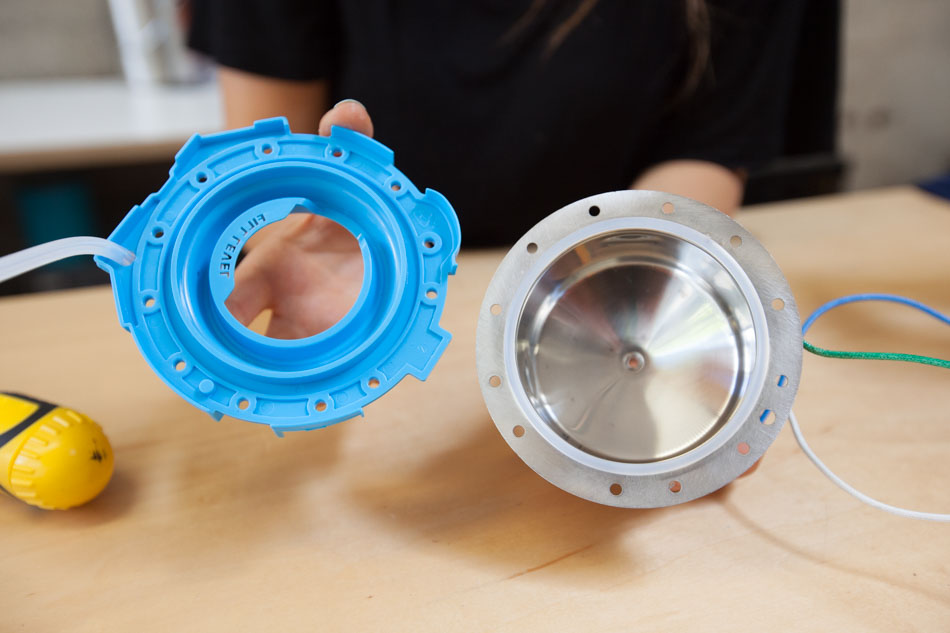
The coils are rated to 120 V or 700 W. Since this water is being heated to 192 degrees, Keurig has another nice warning to ensure our safety 🙂
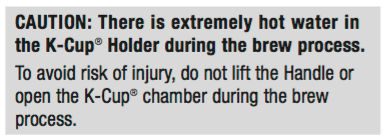
The water is then forced from the water heater, through the K-Cup, and into your coffee cup by air pumps.
Electronics
These air pumps use a diaphragm mini pump that is turned on via a voltage signal and forces air through the top of the water heater. The heated water is forced out through the K-Cup until the height of the water in the water level drops below the height of the outlet hose. The pumps remain on a few seconds after the water level drops, to purge all liquid from the K-cup and tubes.
The pump is rated to 12 V.
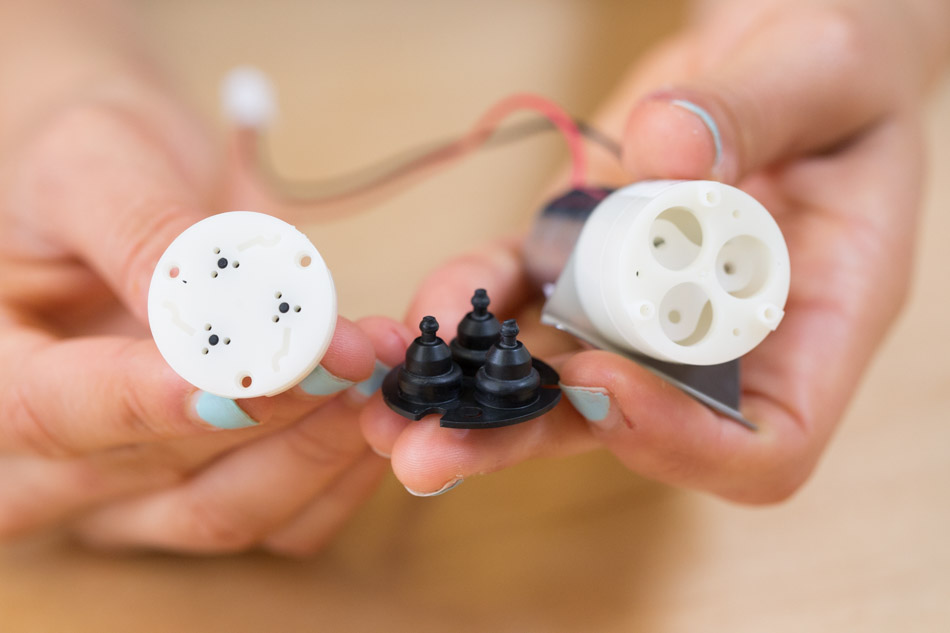
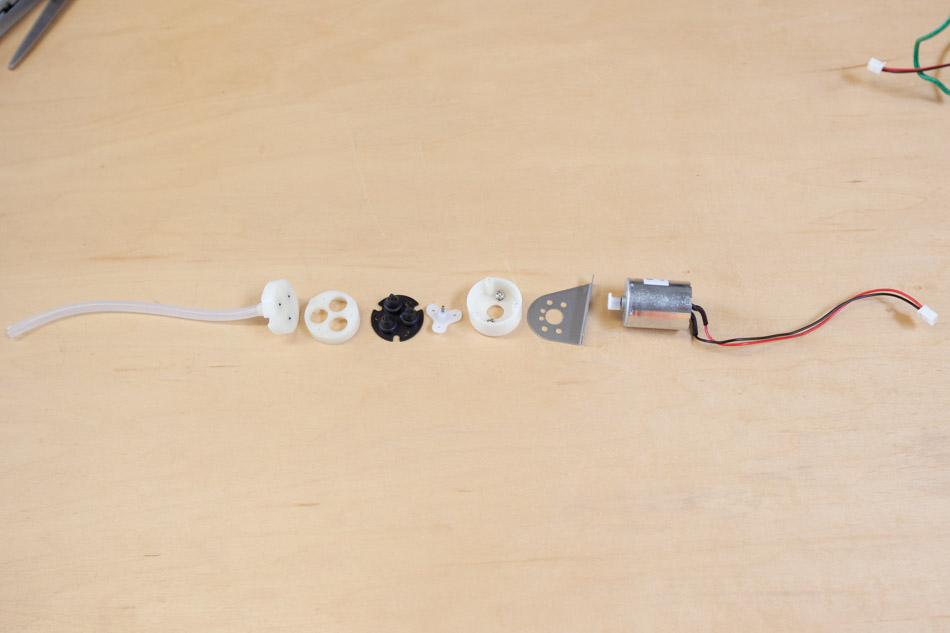
A Therm-O-Disk brand disk thermostat covered in thermal paste is used to measure the temperature of the water tank.

A microswitch detects whether the lid is closed or not.
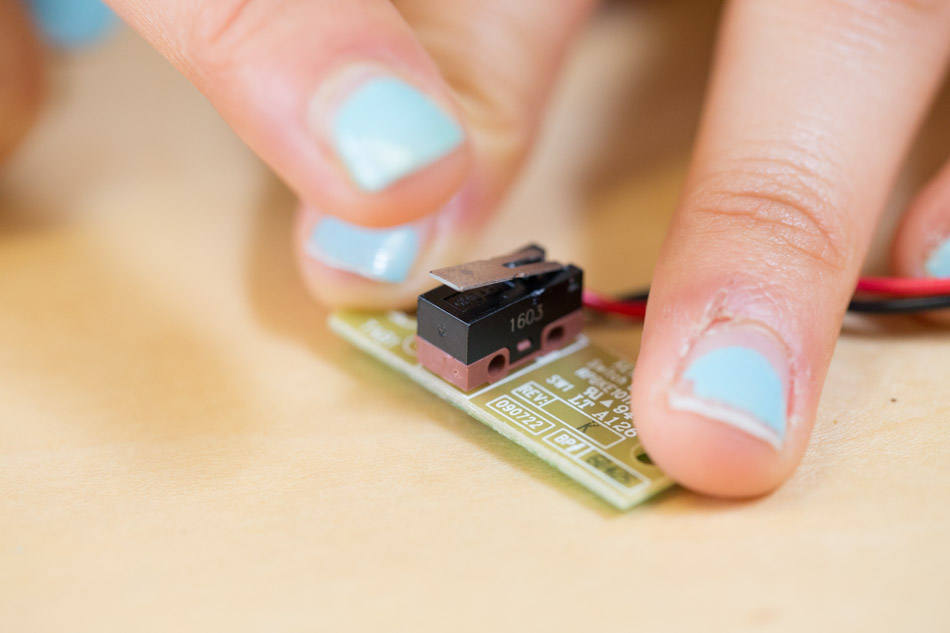
The main PCBA has all peripherals connected to it. It’s not very dense because space isn’t crazy constrained in this product.
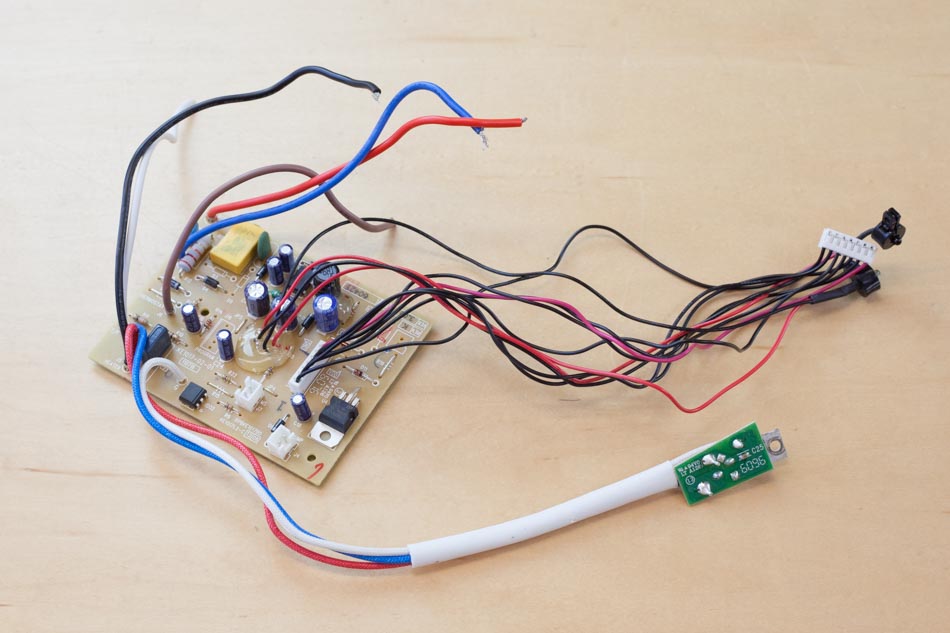
Mechanical Structure
The bottom is a single piece made of injection molded ABS.
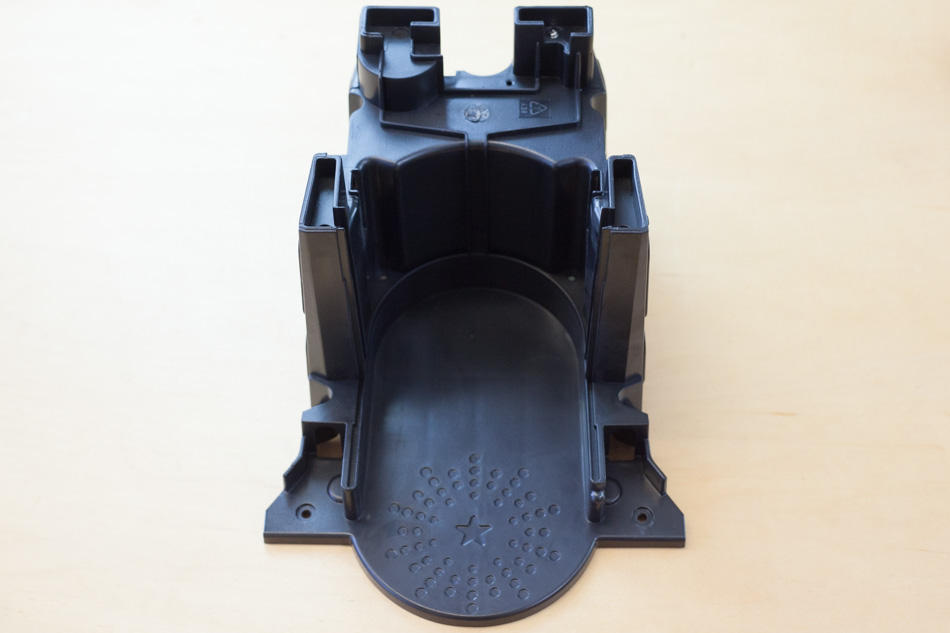
We needed some help from the experts for the rest of the teardown.
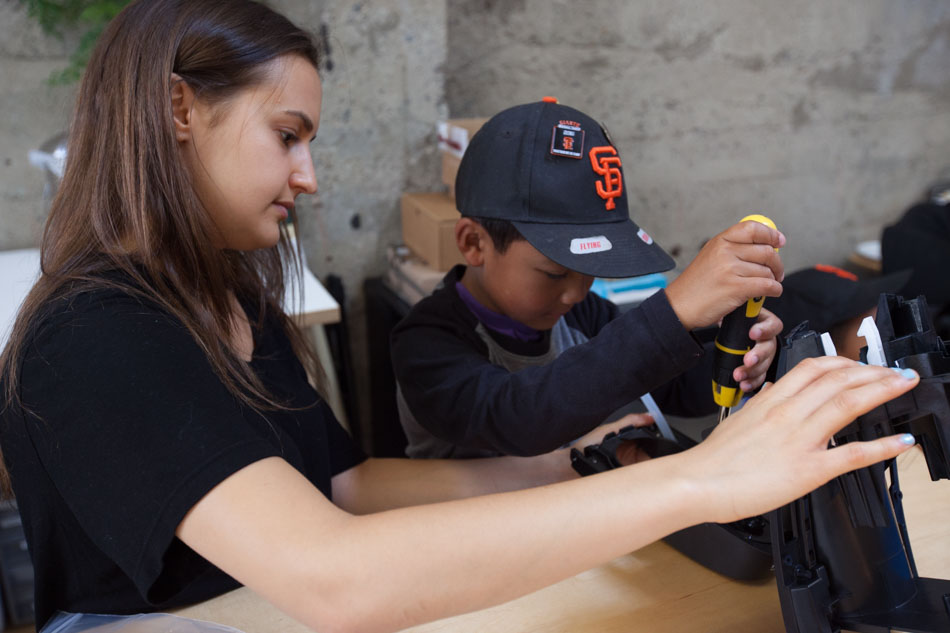

We first unscrewed the apparatus to remove the lid, which had a few screws and a single spring connecting it together. This spring provided resistance to the user when opening and closing the lid to insert and then puncture the K-Cup.
The lid had two pieces: the top cover (left), which held the “PRESS TO OPEN” button, which was made from ABS, and an internal component (right) made from PC/GF, which is an engineering plastic made by adding glass fiber to polycarbonate. It has great mechanical properties, heat distortion temperature, and self-extinguishing characteristics.
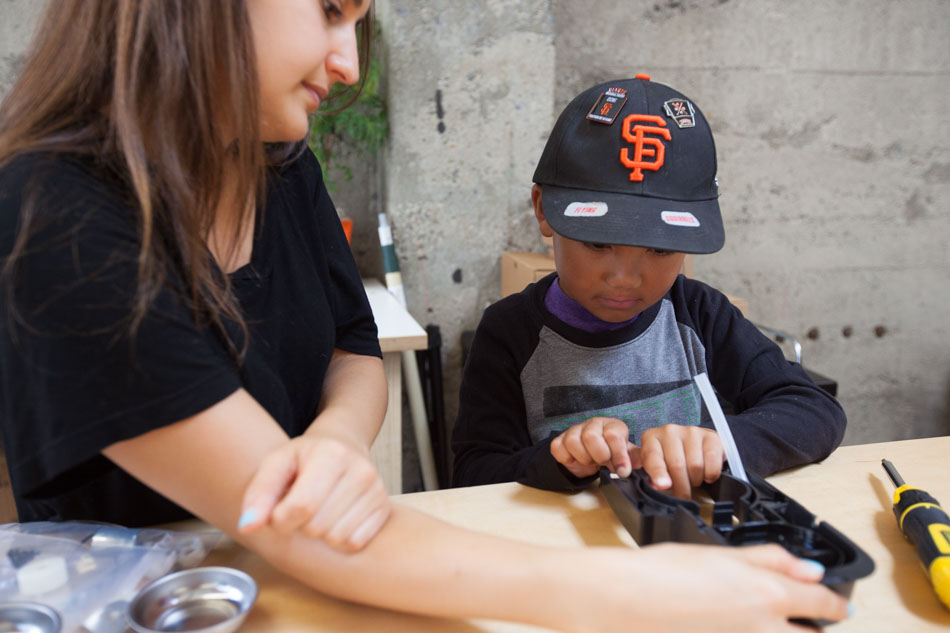
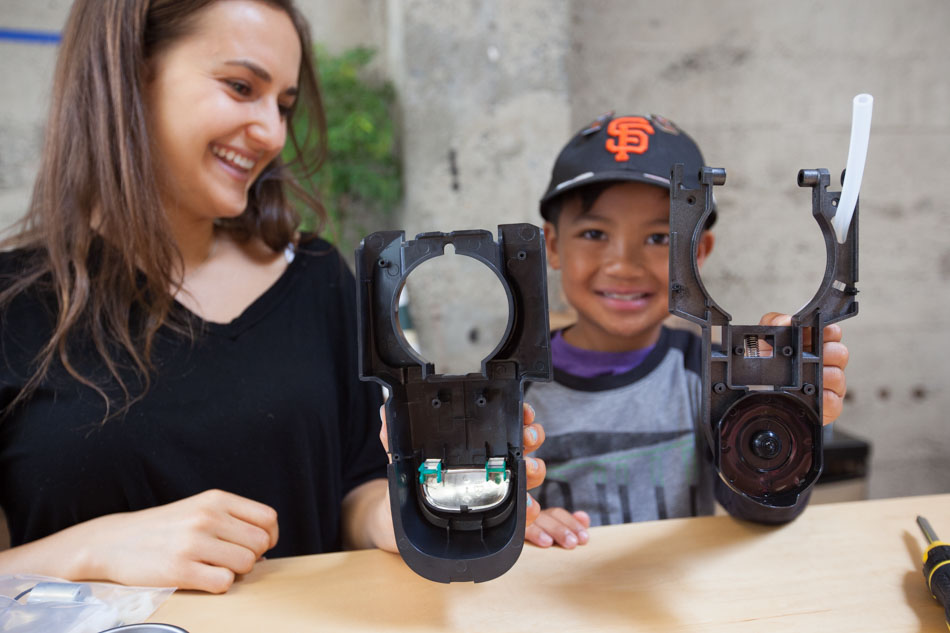
Then the other expert contributed. The PC/GF part had a white POM piece, which implies the need to be stiff, strong and heat resistant. This part connected with another POM piece on the water heater section, explaining the need for a stiffer material with dimensional stability.
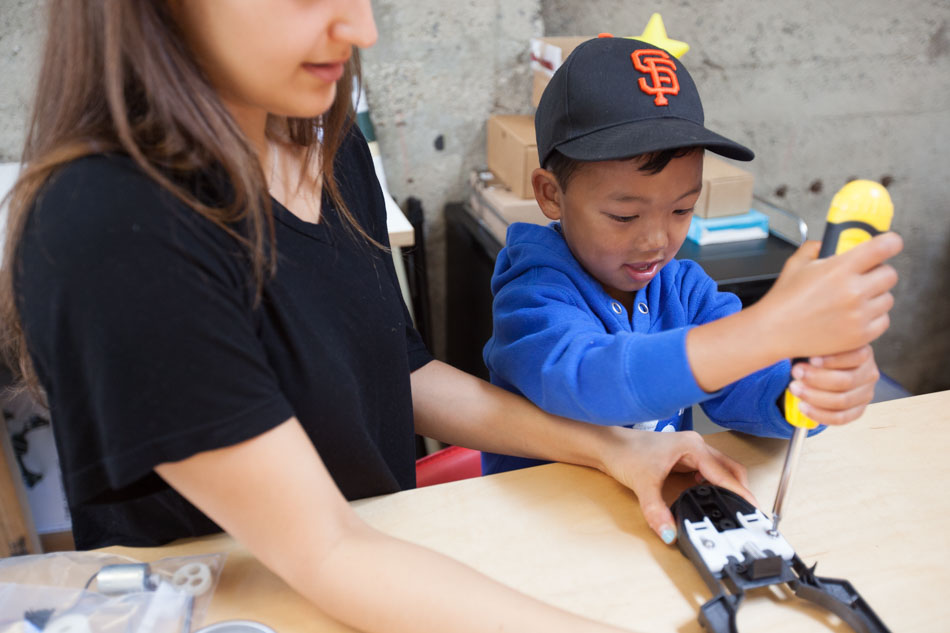
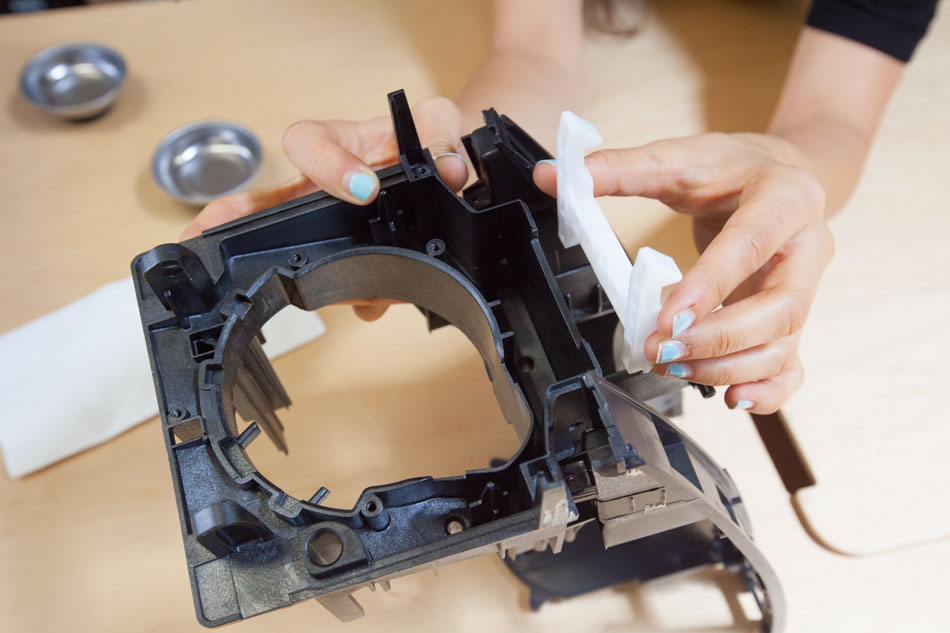
The piece where the K-Cup is inserted is made of three separate components that are all PC/GF for strength. The right two pieces connect via screws, while the left two pieces connect via a guide rail. The guide rail is easily disconnected at the right angle, but the Keurig restricts it from going in that direction, so while the sliding apparatus is quite janky and has the possibility of breaking, the other pieces keep it in place.
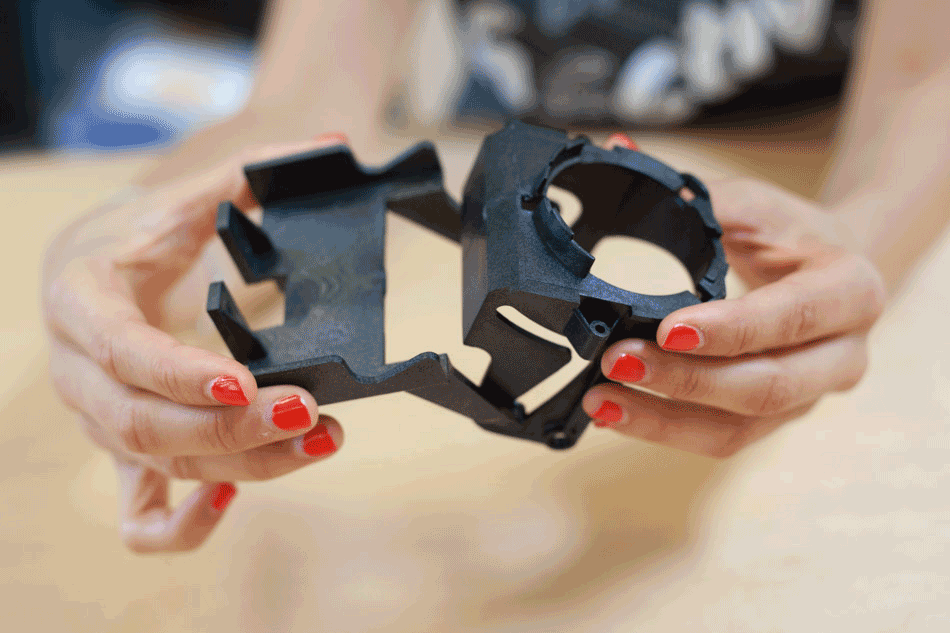
A few last remaining screws, pulls, and wiggles, and we’re done!
There are quite a few different types of plastics in this product, which are all food-safe materials. There’s lots of ABS, which is a low cost engineering plastic that is easy to mold and ubiquitous, and some PP, POM, and PC/GF.
PP is only used on the lifting handle and internal bracket to organize the wire, which is because those pieces are not critical and can therefore be made from a cheaper material. POM and PC/GF are used only on the mechanically important pieces.
The electronics are extremely simple because complexity adds the possibility of failure, and this Keurig doesn’t have any smart functionality. Another major design consideration is the ability to waterproof the components to protect the electronics—lots of elastomer gaskets are used to accomplish this.
Ultimately, the Keurig is much larger and more complicated than we expected. It has tons of parts and is quite large; however, the manufacturer’s suggested retail price is fairly cheap—only $70. This is significantly less than the smaller smart products we’ve torn down in the past.
Therefore, Keurig is probably not making that much profit on the machine itself, but is making money on the coffee pods, instead. More advanced Keurigs have a feature that determines whether they’re branded K-Cups or not—if they’re not, the Keurig doesn’t operate.
Stay caffeinated!


